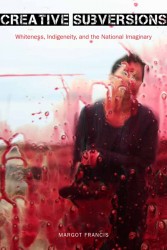Article Origin
Volume
Issue
Year
Creative Subversions: Whiteness, Indigeneity and the National Imaginary
Written By Margot Francis
Published By UBC Press
224 Pages
When you think of Canada and the nationalist image it presents to the world, are there certain images that come to mind? And with these images have you ever thought of where they came from, and the secrecy that lies behind them? Have you ever been challenged to rethink these images you have come to know as a part of Canada’s image?
In Creative Subversions: Whiteness, Indigeneity and the National Imaginary, author Margot Francis explores the national imaginary of Canada using the unique concept of haunting. It is interesting to read that the images we have come to know as a part of Canada have a history and a secrecy behind them that is not considered.
In this text Francis states “although the intellectual work of this project led, on its own account, to a consideration of haunting, the material conditions of writing offered a parallel process, one that also invited me to consider how the experience of ghosts is implicated in the everyday geography of Canadianness.”
She argues that the images we have come to see as a part of Canada’s nationhood—the beaver, the railway, the wilderness of Banff National Park and Indianness—are all veiled in a secrecy and are haunted by ideas of race, masculinity, and sexuality, and it is these images that stem from Canada’s early formative years that we as Canadians have learned to not question.
Francis says much of her writing on spectres was done after working at Algoma University College (AUC) in Sault Ste. Marie, which is “an institution built, literally, from the bricks and mortar of the now (in) famous Shingwauk Residential School,” in quoting cultural theorist Kathleen Brogan.
Francis argues “one of the most frightening aspects of being haunted is its involuntary nature: we cannot choose our ghosts.” Nor do we choose the open secrets of Canadianness. She goes onto explain how ‘secrets’ can provide a way of thinking through what Robert Jay Lifton calls “the potentially transformative influence of death on theory.”
Francis argues that histories of death and dispossession through Canadian nation building is far from exemplary, and draws upon other scholars work, such as Bonita Lawrence and Victoria Freeman, who have similarly argued that if you were “to do an investigation into the history of Indigenous/Anglo-Canadian relations in southern Ontario,” there would be very similar themes.
Creative Subversions: Whiteness, Indigeneity, and the National Imaginary is a complex book, and can be difficult to read. It not only explores aspects of haunting and secrecy in the making of the Canadian nation, it also explores the concepts of “how whiteness and Indigeneity are articulated through icons that we have come to associate with Canadian identity.”
It is a text that is heavy on creative theoretical contributions of Aboriginal and Anglo-Canadian artists who wrestle with the ongoing meanings of Canada in its colonial past and present. Francis does a thorough job in investigating Canadian nationhood and challenges her readers to rethink how everyday objects can be reimagined to challenge how we (the Canadian public) perceive the history we are taught, the memory surrounding it and the national identity we have come to know as Canada.
- 2404 views

